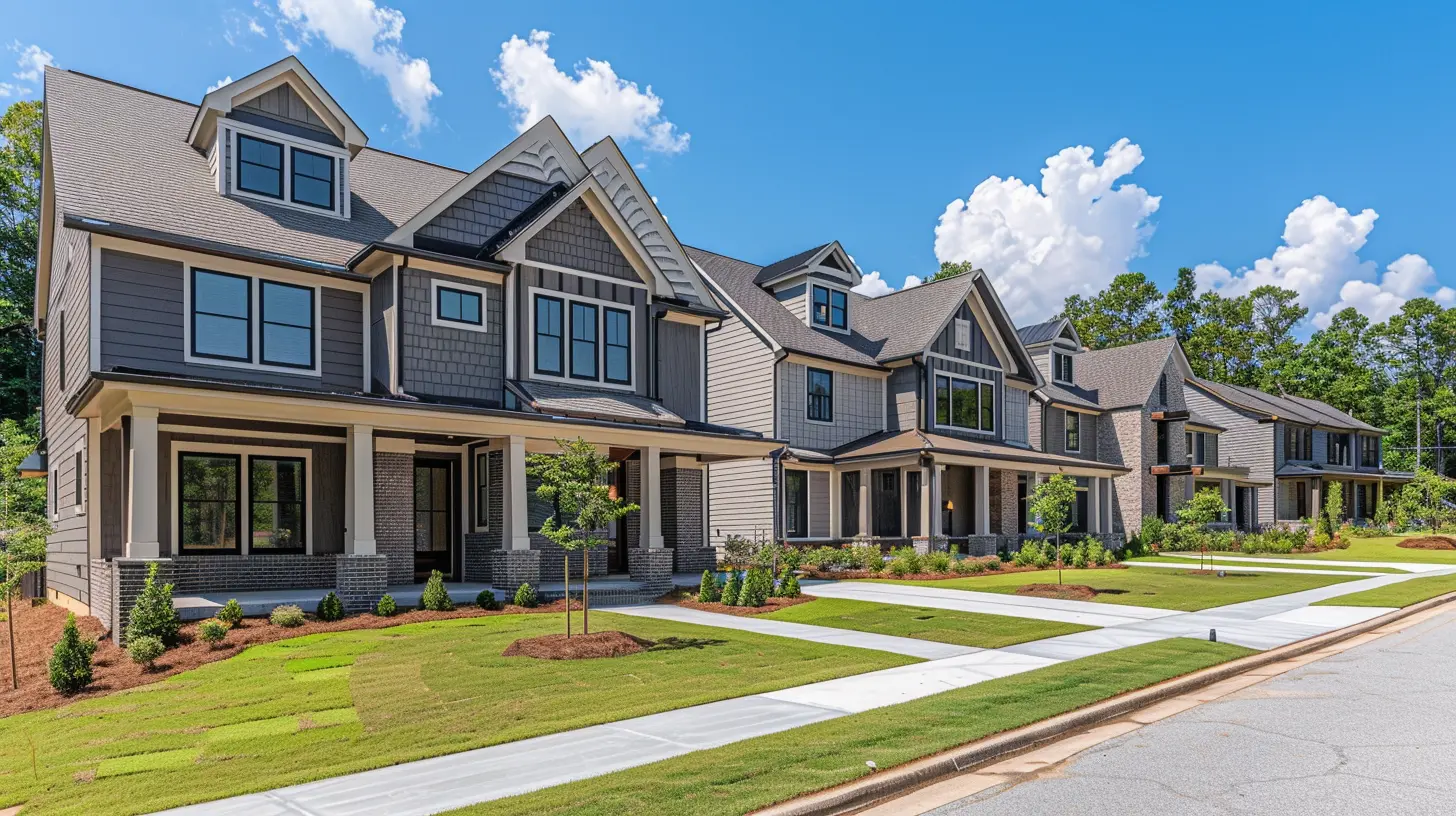Why Housing Inventory Remains Low Despite High Demand
11 May 2025
If you’ve been keeping an eye on the housing market lately or even casually scrolling through listings, you’ve probably noticed something peculiar—there just aren’t that many homes for sale. And if you think you’re the only one frustrated by bidding wars, month-long house hunts, and sky-high prices, trust me, you’re not alone. So, what's up with this low inventory situation, especially when demand is through the roof? Let’s dive into what’s really going on behind the scenes.

The Perfect Storm: A Convergence of Factors
To understand why housing inventory is so low despite sky-high demand, we need to uncover the layers of complexity driving this issue. It’s not just one thing—it’s a cocktail of several factors, all working together to create this perfect storm in the real estate market.
1. Homeowners Are Staying Put Longer
Remember when people used to buy a home, live in it for 5–7 years, and then move on? That used to be the norm, but not anymore. These days, homeowners are staying put significantly longer—around 13 years on average. Why? Several reasons:- They're locked into ultra-low mortgage rates secured during the pre-pandemic years. If you snagged a 3% mortgage rate, would you really want to trade it for a 7% one? Didn’t think so.
- Downsizing doesn’t always make financial sense in today’s market. Even if a homeowner sells their current property at a profit, the price (and competition) for a smaller or newer home can be daunting.
- And let’s not forget about emotional ties—you know, the memories, the neighborhood friends, and the comfort of not wanting to deal with the stress of moving.
2. The Fallout From the 2008 Housing Crisis
Let’s hit rewind for a second. After the 2008 housing market crash, builders dramatically pulled back on new home construction. For a while, it made sense—demand was low, and many construction companies were struggling to survive. But here’s the kicker: They never really returned to pre-crisis building levels, even once the market recovered.Imagine trying to play catch-up while demand piles up over the years—it’s a tough spot to be in. And now, with demand far outpacing supply, we’re paying the price (quite literally) for this decade-long slowdown in construction.
3. Regulations, Zoning Laws, and Rising Costs
Want to build more homes and increase supply? Sounds simple enough, right? Well, not so fast. Builders face a mountain of challenges when it comes to constructing new housing:- Zoning laws: Many areas restrict the type or density of homes that can be built, favoring single-family homes over multi-unit housing.
- Regulations: There's a web of red tape that developers have to navigate, from environmental requirements to building codes.
- Rising costs: Lumber, steel, labor—you name it, it’s more expensive than ever. Even land prices are through the roof! All this makes building homes a more expensive, time-consuming endeavor.
The result? Builders focus on high-end homes, where they can turn a better profit, leaving limited options for first-time buyers or middle-income families. It’s like trying to find an affordable ticket to a sold-out concert—good luck with that.
4. Fewer Foreclosures and Distressed Sales
Foreclosures and distressed sales used to be a steady pipeline for housing inventory. After the 2008 crisis, many homes hit the market this way, providing opportunities for buyers and investors alike. But as the economy has improved, foreclosure rates have dropped significantly. That’s obviously great news for homeowners but bad news for inventory levels.On top of that, pandemic-related protections, like mortgage forbearance programs, kept struggling homeowners in their properties instead of forcing them into foreclosure. Fewer distressed properties mean fewer options for buyers.
5. Investors and the Rise of Institutional Buyers
If you’re trying to buy a home and keep getting outbid, you might not just be competing against other families—investors are in the mix too. Both mom-and-pop landlords and big institutional investors are snapping up single-family homes like they’re candy on Halloween. Why? Real estate is seen as a relatively safe and lucrative investment, especially in a hot market.These investors often buy properties in bulk or pay in cash, making it hard (if not impossible) for the average buyer to compete. And the kicker? Many of these homes end up as rentals instead of being resold, further exacerbating the inventory issue.
6. Pandemic Ripple Effects
The COVID-19 pandemic didn’t just shake up our lives—it disrupted the real estate market in a big way. Here’s how:- Remote work shifted demand: People started moving away from city centers, looking for more space and homes in suburban or rural areas. This sudden geographical shift increased demand in markets that weren’t prepared for it.
- Supply chain issues: Construction materials became harder to source, delaying new builds. Even something as simple as getting windows delivered on time became a logistical nightmare for builders.
- Economic uncertainty: Many homeowners decided to hold off on selling, not wanting to gamble with timing during such an unpredictable period.
7. Psychology Plays a Role, Too
Let’s not underestimate the psychological side of things. When homeowners hear about low inventory and skyrocketing prices, they might hesitate to list their homes. Why? They’re worried about where they’ll go next. Selling might get them a good price, but if they can’t find a new home to move into, they’re stuck. It’s a classic catch-22: people won’t sell because there aren’t enough homes, and there aren’t enough homes because people won’t sell.8. Demographics Driving Demand
And then there’s the sheer number of people looking to buy homes, especially as younger generations enter the market. Millennials, who make up the largest segment of the U.S. population, are finally hitting their homebuying years. Add in Gen Z right behind them, and you’ve got a massive wave of demand.But here’s the problem: The housing stock hasn’t kept up with this population growth. We’re basically trying to fit a square peg into a round hole.
So, What’s Being Done to Fix It?
You might be wondering, “Okay, this all makes sense, but what’s the solution?” Unfortunately, there’s no quick fix here. Addressing low housing inventory takes time and cooperation among policymakers, builders, and communities. Here are a few things that could help:- Updating zoning laws to allow for more diverse housing types, like duplexes or townhomes.
- Incentivizing builders to focus on affordable housing.
- Streamlining building processes to cut through red tape.
- Encouraging community land trusts or initiatives that prioritize housing affordability.

The Bottom Line
Low housing inventory isn’t a problem with a one-size-fits-all solution. It’s the result of a tangled web of economic, regulatory, and social factors, all coming together to create the market we’re seeing today. If you’re a buyer, patience (and maybe a little luck) will be your best friend. And if you’re a seller? Well, you’re sitting on gold right now.One thing’s for sure: Understanding the “why” behind this issue helps us better navigate the challenges, whether you’re buying, selling, or just anxiously watching from the sidelines. So, what do you think—ready to wait it out, or are you diving in headfirst?
all images in this post were generated using AI tools
Category:
Housing MarketAuthor:

Elsa McLaurin
Discussion
rate this article
5 comments
Caden Becker
This topic is fascinating! It’s intriguing to explore the complex factors behind low housing inventory despite high demand. I’m curious about how market dynamics and policies might evolve in response.
May 26, 2025 at 4:00 AM

Elsa McLaurin
Thank you! It's definitely a complex issue, and I appreciate your interest in how market dynamics and policies might shift to address these challenges.
Leah Wheeler
While demand surges, low housing inventory reflects systemic challenges, including zoning restrictions and construction delays. Addressing these issues is crucial for balancing the market and meeting buyer needs effectively.
May 19, 2025 at 2:50 AM

Elsa McLaurin
Thank you for your insights! You highlight key factors that significantly impact housing inventory. Addressing zoning and construction challenges is indeed essential for a more balanced market.
Runehart Mercado
Looks like housing inventory is playing hard to get! With demand soaring and homes hiding like shy turtles, buyers may need some patience—or a great sense of humor! Here’s hoping the market reveals its secrets soon. 🐢🏡✨
May 17, 2025 at 3:34 AM

Elsa McLaurin
Thanks for your insightful comment! It’s true—patience and humor are key as we navigate this tight housing market. Hopefully, more inventory will surface soon! 🏡✨
Ian McWilliams
The persistent low housing inventory amid high demand highlights a complex interplay of market dynamics. Limited new construction, increased material costs, and homeowners hesitant to sell due to rising mortgage rates contribute significantly. This imbalance underscores the need for strategic solutions to stimulate supply while addressing affordability for prospective buyers.
May 13, 2025 at 2:25 AM

Elsa McLaurin
Thank you for your insightful comment! You've captured the key factors driving the low inventory perfectly. Addressing these challenges is essential for creating a more balanced housing market.
Zephira Stevens
Great insights! It's a puzzling market for sure. With so many eager buyers but limited options, it feels like trying to find a parking spot in a crowded lot. Hopefully, more homes will hit the market soon so everyone can find their perfect fit! Thanks for the thoughtful article!
May 11, 2025 at 7:50 PM

Elsa McLaurin
Thank you for your feedback! I share your hope for more inventory to help buyers find their ideal homes.




